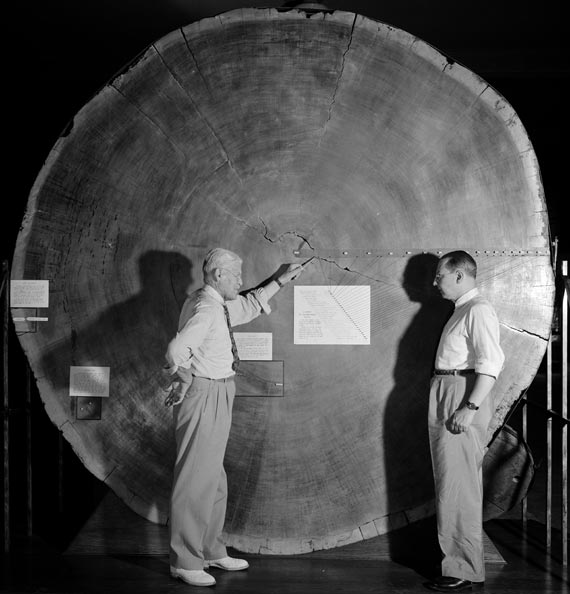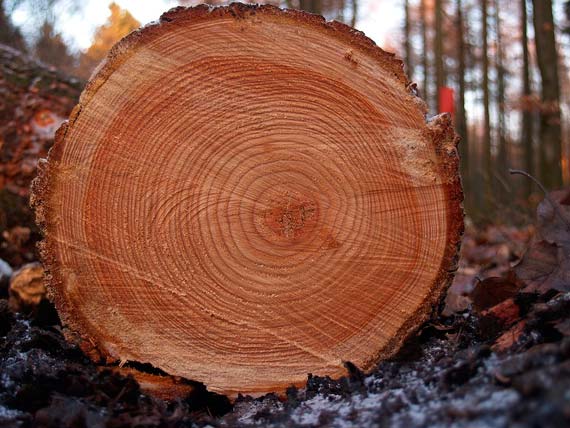For many of us, the name Andrew Ellicott Douglass will not be familiar, but perhaps you have seen his face, even without knowing it. In his most famous picture, Douglass is standing in front of a cross section of a giant sequoia tree trunk that’s twice his height, with labels indicating the thickness of the tree in certain historical periods. Douglass’s great contribution to science, the dating of trees by the growth rings in their trunks, is well known today; but what’s less well known is the fact that the applications of these studies go beyond botanical curiosity to serve as paleoclimatic records and as calendars that, in their day, enabled major archaeological sites in the United States to be dated. And all this despite the fact that Douglass was indeed pursuing something very different that he was never able to prove.

Andrew Ellicott Douglass (July 5, 1867 – March 20, 1962) was born in Windsor (Vermont, USA) into a prominent family linked to the clergy and academia. He inherited his name (and a passion for astronomy) from his grandfather, who had been the first to record a meteor shower in North America. With his studies in astronomy, geology and physics in hand, Douglass joined the Harvard Observatory as an assistant, a job that took him on an expedition to Peru and on a tour around Europe. In 1894, the wealthy amateur astronomer Percival Lowell hired him with the goal of selecting a site in Arizona on which to place a telescope to observe Mars. Douglass moved to what was then the Far West and chose the town of Flagstaff, where the Lowell Observatory was erected and where it has remained until today.
The trajectory of Douglass as Lowell’s second in command ended abruptly because of Lowell’s obsession to prove the existence of a Martian civilization. Lowell insisted on seeing artificial canals on Mars, something that neither Douglass nor the rest of the scientific community supported. The conflict between the two ended with the dismissal of Douglass in 1901. According to Donald J. McGraw, a biologist and science historian who has written extensively on Douglass’ work, it was between this moment and his transfer to the University of Arizona in Tucson in 1906 when the astronomer became interested in the dating of the growth rings of trees.
The annual nature of the rings first appears in the writings of Leonardo da Vinci, who acknowledged that their thickness depended on moisture conditions. In the eighteenth and nineteenth centuries, other scientists advanced the study of the rings and their relationship with climate, starting to cross-date trees to effectuate dating. Meanwhile, Douglass was strengthening his career as an astronomer in Tucson, founding in 1916 the Steward Observatory on University lands where an ostrich farm had previously been located.

Douglass’s approach to tree rings had a merely instrumental purpose. The astronomer was, in McGraw’s words, “consumed by a passion” to show the influence of solar cycles on the Earth’s climate. “As an astronomer, his primary interest was solar activity,” says McGraw to OpenMind. “He thought the 11-year sunspot cycle could be found in the climate history of tree rings.” This would lead him to “create on his own the then-new science of dendrochronology,” continues McGraw, and to found in 1937 the Laboratory of Tree-Ring Research at the University of Arizona, the first of its specialty.
In this way Douglass became the leading authority on the study of tree rings, thanks mainly to the slabs of ancient giant sequoias. His work and his first publications came to the knowledge of archaeologists from the American Museum of Natural History, who requested his help to date the ancient Anasazi ruins in the American Southwest through the wooden beams used by the natives in their constructions.
The astronomer began working on this in 1916, but for years it was only feasible to assign “floating” chronologies to the beams; that is, the beams related to each other, but it wasn’t possible to fix them on the calendar as there was a time gap between them and the absolute dates obtained in Flagstaff. Finally, on June 22, 1929, the analysis of a beam called HH-39, found in Showlow (Arizona), allowed both chronologies to overlap and date the Anasazi ruins. In December 1929, Douglass wrote in National Geographic magazine that the HH-39 beam was destined to occupy a place in American archeology “comparable to the Egyptian Rosetta stone.” And so it was; today dendrochronology is used worldwide for dating purposes, as well as for reconstructing the climate of the past and understanding the present.
Douglass died at age 94 without fulfilling his dream of showing traces of the solar cycle in tree rings. “He was never able to prove it, nor has anyone else,” says McGraw. “But some studies suggest, although it’s a conjecture, a possible cycle of 22 years in the rings, double the sunspot cycle. Its significance, if it’s real, is unclear.” Nevertheless, Douglass will always be for McGraw like the redwoods that he studied, a “giant immortal.”
Comments on this publication